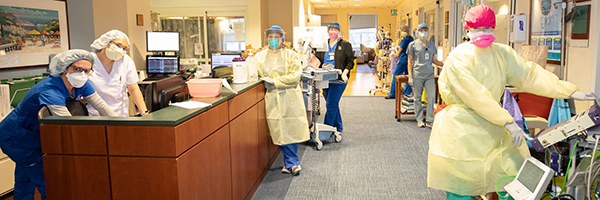EP6EO
Interprofessional Care EP6EO
- Provide one example, with supporting evidence, of an improvement in a defined patient population outcome associated with nurse participation in an interprofessional collaborative plan of care.
- Patient outcome data must be in the form of a graph with a timeline data table.
Example: Nurse Participation in an Interprofessional Collaborative Plan of Care Increases Total Knee Replacement Patients Discharged to Home
Problem
Greenwich Hospital’s interprofessional Total Joint and Spine Steering Committee includes nurses, surgeons, physical therapists, case managers, anesthesiologists and surgical service line leadership. The committee meets monthly to review data on patient volume, length of stay, discharge disposition and Joint Commission metrics. The Total Joint and Spine Steering Committee evaluated existing discharge practices and found that in 4th Quarter 2016 only 16.5% of total knee replacement patients were discharged to home post-operatively rather than a skilled nursing facility. Evidence demonstrates that patients who are discharged to home rather than to a skilled nursing facility have better outcomes in terms of healing, infection rates and functional mobility.
Goal Statement
Increase percentage of total knee replacement patients that are discharged to home post-operatively.
Participants
Total Joint and Spine Steering Committee
|
|||
Name/Credentials |
Discipline |
Title/Role |
Department |
Ann Nardi, DPT, PT |
Physical Therapist |
Coordinator of the Total Joint Replacement Program |
Surgery Unit |
Sheila Finn, MSN, RN |
Nursing |
Clinical Coordinator, Clinical Nurse |
Surgery Unit |
Kasey Connor, MSN, RN, OCN |
Nursing |
Clinical Nurse, Clinical Resource Nurse |
Surgery unit |
Peggy Lennon, MSN, RN, NE-BC |
Nursing |
Program Director |
Surgical Services |
Marie Pham, BSN, RN, AORN |
Nursing |
Manager |
Operating Room |
Patricia Babcock, BSN, RN |
Nursing |
Director |
Case Management |
Helene Kimmons, BSN, RN, CAPA |
Nursing |
Manager |
Ambulatory Surgery and PACU |
Carolyn Bender, BSN, RN, CIC |
Nursing |
Infection Preventionist |
Infection Control |
Jessie Riemer, MSN, RN, CPHQ |
Nursing |
Senior Performance Management Specialist |
Performance Management |
Margaret Dorrance, RN |
Nursing |
Nurse Case Manager |
Case Management |
Marcelle Husband, BSN, RN |
Nursing |
Nurse Case Manager |
Case Management |
Rebecca Boutsikoudis, LCSW |
Social Work |
Social Worker Case Manager |
Case Management |
Brian Kavanagh, MD |
Orthopedic Surgeon |
Medical Director, Total Joint Replacement Program |
Orthopedics |
Thomas Milucci, DPT, PT |
Physical Therapist |
Director |
Physical Medicine |
Julie Wahnish, PT, DPT |
Physical Therapist |
Inpatient Coordinator |
Physical Medicine |
Jaclyn Kito, PT, DPT |
Physical Therapist |
Physical Therapist |
Physical Medicine |
Mark Chrostowski, MD |
Anesthesiologist |
Anesthesiologist |
Anesthesia |
Description of the Intervention
1st Quarter 2017-3rd Quarter 2018
The interprofessional members of the Total Joint and Spine Steering Committee conducted a literature review to identify best practices for safe discharge for the total knee patient population. The committee identified that the literature supported discharge to home as a safe discharge plan with effective preoperative assessments and patient education. Based on the committee members’ review and discussion, they identified the need to develop an interprofessional discharge planning assessment tool. The tool would provide valuable assessment data to incorporate an interprofessional collaborative plan of care for discharge for the total knee population, incorporating an assessment of the patients’ home setting as well as physical, medical and social needs.
The discharge tool is used to evaluate whether the patient can be discharged home or requires discharge to a rehab facility. If the patient has optimal cognitive functioning and an optimal environment at home – no more than two steps into the home dwelling and a caretaker available to provide support and assistance – then the patient is to plan for home discharge. If the patient has functional decline, more than two stairs at home and no caregiver, they are set up for rehab placement. The intent was for patients to complete the discharge tool preoperatively, with the interprofessional team then using the information collected to facilitate a safe discharge plan. The tool assists the nurse and interprofessional team to collaboratively prepare a safe patient discharge.
Trial of the Discharge Planning Assessment Tool
The Total Joint and Spine Steering Committee agreed to conduct a trial of the new discharge planning assessment tool. Ann Nardi, DPT, PT, Coordinator of the Total Joint Replacement Program, and Kasey Connor, MSN, RN, Clinical Nurse, Clinical Resource Nurse teach the Preoperative Total Knee class. During the trial, they began educating patients and caregivers on completing the tool. Options for a safe discharge, including discharge to home, were incorporated into to the education.
Nardi and Connor collected and analyzed the data from the trial. The Total Joint and Spine Steering Committee reviewed the data and evaluated the effectiveness of the tool by monitoring the following monthly: accuracy of the discharge planning assessment tool and the percentage of total knee patients discharged to home rather than to a rehab facility based on the score of the tool.
Based on the data gathered from the trial, the Total Joint and Spine Steering Committee revised the tool to make it more specific and to include in the preoperative assessment the measure of independence with activities of daily living (ADL). The revised tool included questions about ADLs, bathing, dressing, preparing meals and level of activity.
All interventions were fully implemented by the end of 3rd Quarter 2018.
Outcomes
Nurse participation in an interprofessional collaborative plan of care for total knee replacement patients led to an improved patient outcome.
In the three quarters following implementation, the percentage of total knee replacement patients discharged home increased to 59.6% in 4th Quarter 2018, 59.3% in 1st Quarter 2019 and 64% in 2nd Quarter 2019.

Evidence EP6EO-1, Greenwich Hospital Percentage of Total Knee Replacement Patients Discharged to Home Post-operatively

